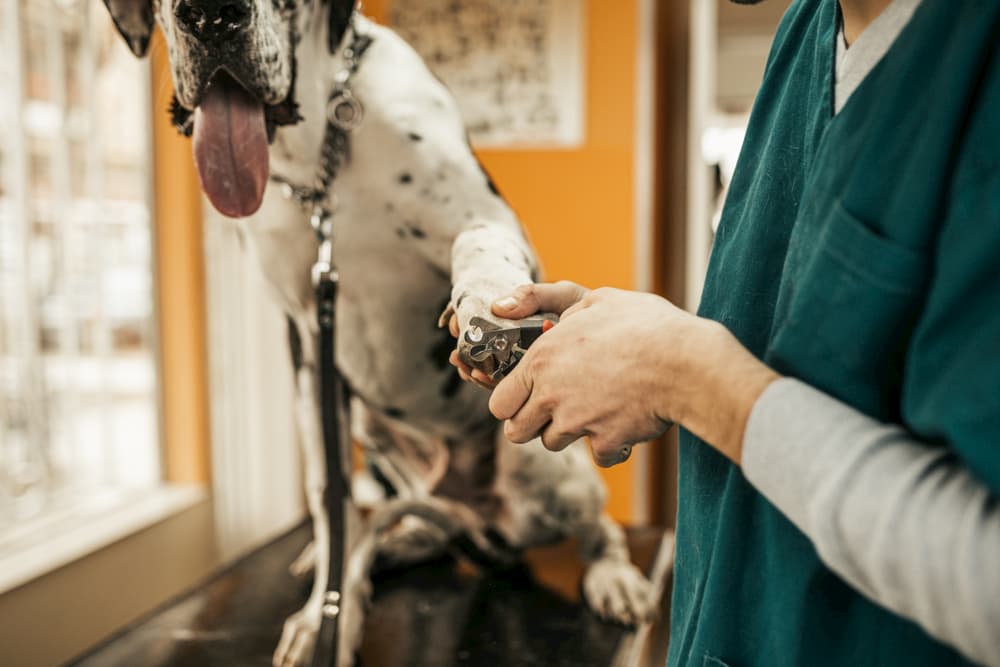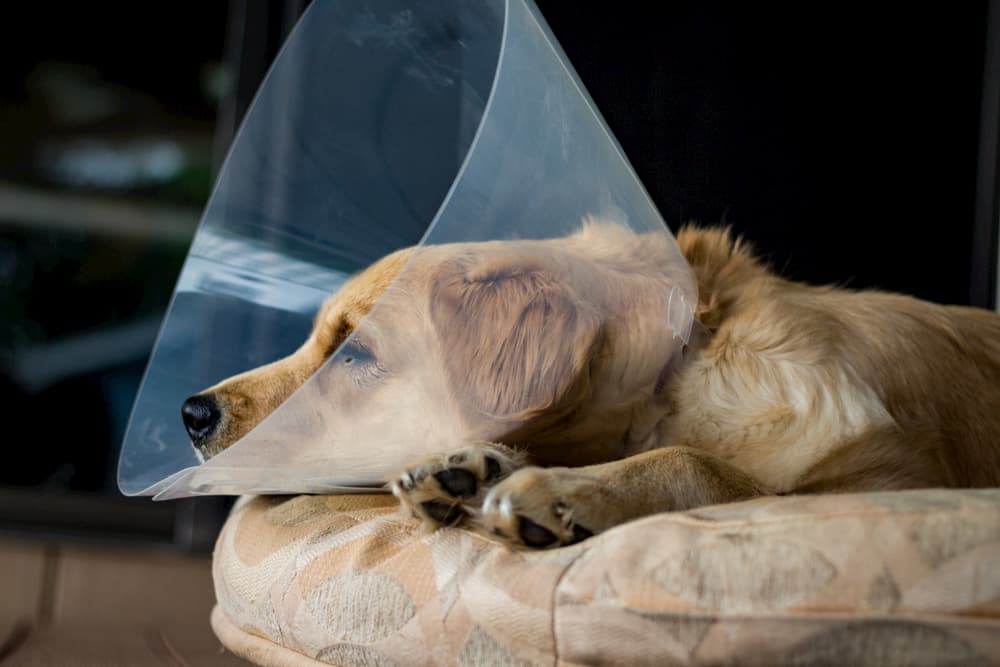Acral Lick Dermatitis (Lick Granuloma) in Dogs

Overview
- A lick granuloma is a chronic skin problem caused by excessive licking and is a lick-itch cycle.
- Lick granulomas are generally seen in middle-aged to older, large breed dogs.
- Lick granulomas are caused by self-trauma, either emotionally or physically, which causes excessive licking.
- The most commonly affected areas are on the legs: on the top of the wrist, around the ankle, and on toes.
- Lick granulomas can be tough to treat. Time and patience are required to clear up this problem.
If your dog won’t stop licking at a sore on his leg, it might be a lick granuloma, also known as acral lick dermatitis.
These skin lesions can be frustrating for both dogs and people. While licking is part of normal grooming behavior, sometimes things can get out of hand and you need some help to know what is going on and more importantly, how to stop it from happening.
What is a Lick Granuloma?

A lick granuloma is a chronic skin problem caused by excessive licking. They occur when a dog keeps licking one specific area of their bodies. This then makes the skin itch or hurt, which causes more licking and chewing to happen. This is followed by inflammation and infection, and then—you guessed it—more licking.
It’s a vicious lick-itch cycle that causes angry, reddened, chronically irritated skin that can look scarily like a skin tumor.
Lick granulomas are generally seen in middle-aged to older, large breed dogs. Male and female dogs are equally affected.
This condition is especially common in certain breeds including:
- Labrador Retrievers
- Doberman Pinschers
- Great Danes
- Golden Retrievers
- Boxers
- Akitas
- Dalmatians
- Irish Setters
- English Setters
- Shar-Peis
- Weimaraners
What Causes Granulomas in Dogs?

Lick granulomas are caused by self-trauma. Something bothers the dog, either mentally or in the area of the body where the licking occurs, and the dog begins to lick that one area over and over again until the hair falls out and the skin gets red and inflamed. Over time, the skin thickens or becomes infected.
Having said that, there are a myriad of conditions that can bother a dog enough to create a lick granuloma, including:
- Skin allergies or hypersensitivities
- Bacterial or fungal skin infections
- Skin mites, especially demodex mites
- Underlying joint pain or osteoarthritis
- Trauma to the skin (bruises, cuts, abrasions, etc.)
- Skin cancer
- Foreign body under the skin (grass awns or splinters)
- Neuropathies (nerve pain or sensory nerve dysfunction)
- Behavioral problems associated with compulsive licking
- Stress and anxiety
- Licking due to stress from boredom or lack of mental and physical exercise
Lick Granuloma Symptoms in Dogs

Lick granulomas all have one common symptom: excessive licking of skin in one spot, enough to cause problems.
The most commonly affected areas of the body are on the legs: on the top of the wrist, around the ankle, and in between or on top of the toes.
Additional symptoms include:
- Hair loss in affected area
- Eroded or ulcerated skin from being licked so much
- Raised, reddened plaques or nodules
- Itchiness
While acral lick dermatitis usually only occurs in one area, in some cases, a dog can have multiple areas of the body affected.
How to Diagnose a Lick Granuloma in Dogs

If you think your dog has a lick granuloma, then it is time to make an appointment with your veterinarian to have your dog examined. After examination, your vet may recommend some testing to determine why your dog is licking.
Depending on what your vet suspects, these tests may include:
- Skin scraping
- Culture for ringworm
- Skin testing for bacterial infection
- Bloodwork to check for hormonal conditions
- X-rays to look at the bones and joints
- Allergy testing for skin allergies
- Food-elimination test to check for food allergies
- Neurological testing to check for nerve disorders
- Orthopedic exam to check for joint pain or problems
- Behavioral consult to check for psychological causes
- Skin biopsy to rule out skin cancer
Lick Granuloma Treatment

Unfortunately, lick granulomas can be tough to treat especially if no underlying cause is found. Time and patience are required to clear up this problem.
Treatment consists of healing the acral lick granuloma, preventing licking, managing any pain, and fixing the underlying cause if one is found.
Treatments for lick granulomas in dogs may include:
Topical Ointments
These may include lotion, cream, or ointment applied directly to the lick granuloma. These medications are typically a combination treatment that includes some combination of antibiotics, steroids, anti-inflammatories, and pain medication.
The medication is applied until the condition resolves. Dogs must be kept from licking the medication off for at least 15 minutes after application, and pet parents should wear gloves when using this medication to avoid any accidental absorption. Cost of topical medications to treat lick granulomas range from $40-$80. You must treat the lick granuloma until it disappears entirely.
Oral Antibiotics and Antihistamines

Oral antibiotics and antihistamines are used to treat skin infections or allergies. Cost depends on the size of the dog, type of medication used, how long a dog has to be treated, and can range from $40-$150.
Behavioral Therapy and Medications
Therapy and behavioral drugs may be used if there is a psychological component to your dog’s licking. Behavioral drugs that have been used to treat psychogenic licking include tricyclic antidepressants and dopamine antagonists, like naltrexone. Prices range, and a minimum of 4 weeks of therapy is recommended.
Allergy Therapy
Drugs such as Apoquel or injectable Cytopoint may be prescribed, or a food elimination trial with a hypoallergenic therapeutic diet may be prescribed to deal with an allergy. Prices vary. Apoquel is a commonly prescribed oral medicine for allergic itch in dogs that starts working within four hours.
Light Therapy
Photobiomodulation, also known as cold or low-level laser therapy, has been shown to be of benefit to some dogs in reducing pain and inflammation. Additionally, fluorescent light therapy can aid in the treatment of skin lesions like lick granulomas. The price of these treatments may vary.
Lick Prevention Products

Preventing licking with bandages, T-shirts, or e-collars may be necessary to interrupt licking behavior.
If you have cost concerns about medications, ask about generic medications, over the counter human medications that can be used, getting an online prescription, or scripting out to a big box pharmacy.
How to Prevent Lick Granulomas in Dogs
The best way to prevent lick granulomas in dogs is to stop the problem before it starts. If you notice that your dog is licking one part of his body more than usual, talk to your veterinarian as soon as possible to avoid a little problem becoming bigger and harder to solve.
Having your dog examined regularly, as recommended by your veterinarian, and addressing any possible underlying causes early will also help prevent lick granulomas from happening.
If your dog licks excessively due to stress or anxiety, then increasing exercise and asking your vet for pointers on how to reduce stress for your dog can help prevent any behavioral licking problems.
Related Conditions
- Demodex
- Ringworm
- Cancer
- Deep bacterial skin infection









